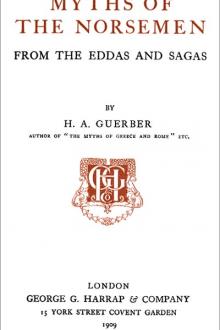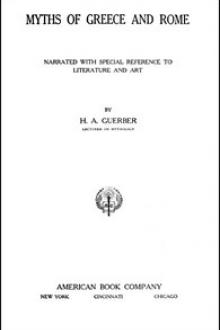Myths of the Norsemen, H. A. Guerber [ereader manga TXT] 📗

- Author: H. A. Guerber
- Performer: -
Book online «Myths of the Norsemen, H. A. Guerber [ereader manga TXT] 📗». Author H. A. Guerber
The myth of Idun’s fall from Yggdrasil into the darkest depths of Nifl-heim, while subject to the same explanation and comparison as the above story, is still more closely related to the tale of Orpheus and Eurydice, for the former, like Bragi, cannot exist without the latter, whom he follows even into the dark realm of death; without her his songs are entirely silenced. The wolf-skin in which Idun is enveloped is typical of the heavy snows in Northern regions, which preserve the tender roots from the blighting influence of the extreme winter cold.
The Van Niörd, who is god of the sunny summer seas, has his counterpart in Neptune and more especially in Nereus, the personification of the calm and pleasant aspect of the mighty deep. Niörd’s wife, Skadi, is the Northern huntress; she therefore resembles Diana. Like her, she bears a quiver full of arrows, and a bow which she handles with consummate skill. Her short gown permits the utmost freedom of motion, also, and she, too, is generally accompanied by a hound.
The story of the transference of Thiassi’s eyes to the firmament, where they glow like brilliant stars, reminds us of many Greek star myths, and especially of Argus’s eyes ever on the watch, of Orion and his jewelled girdle, and of his dog Sirius, all changed into stars by the gods to appease angry goddesses. Loki’s antics to win a smile from the irate Skadi are considered akin to the quivering flashes of sheet-lightning which he personified in the North, while Steropes, the Cyclops, typified it for the Greeks.
The Northern god of sunshine and summer showers, the genial Frey, has many traits in common with Apollo, for, like him, he is beautiful and young, rides the golden-bristled boar which was the Northern conception of the sunbeams, or drives across the sky in a golden car, which reminds us of Apollo’s glittering chariot.
Frey has some of the gentle Zephyrus’s characteristics besides, for he, too, scatters flowers along his way. His horse Blodug-hofi is not unlike Pegasus, Apollo’s favourite steed, for it can pass through fire and water with equal ease and velocity.
Fro, like Odin and Jupiter, is also identified with a human king, and his mound lies beside Odin’s near Upsala. His reign was so happy that it was called the Golden Age, and he therefore reminds us of Saturn, who, exiled to earth, ruled over the people of Italy, and granted them similar prosperity.
Gerda, the beautiful maiden, is like Venus, and also like Atalanta; she is hard to woo and hard to win, like the fleet-footed maiden, but, like her, she yields at last and becomes a happy wife. The golden apples with which Skirnir tries to bribe her remind us of the golden fruit which Hippomenes cast in Atalanta’s way, and which made her lose the race.
Freya, the goddess of youth, love, and beauty, like Venus, sprang from the sea, for she is a daughter of the sea-god Niörd. Venus bestowed her best affections upon the god of war and upon the martial Anchises, while Freya often assumes the garb of a Valkyr, and rides rapidly to earth to take part in mortal strife and bear away the heroic slain to feast in her halls. Like Venus, she delights in offerings of fruits and flowers, and lends a gracious ear to the petitions of lovers. Freya also resembles Minerva, for, like her, she wears a helmet and breastplate, and, like her, also, she is noted for her beautiful blue eyes.
Odur, Freya’s husband, is like Adonis, and when he leaves her, she, too, sheds countless tears, which, in her case, are turned to gold, while Venus’s tears are changed into anemones, and those of the Heliades, mourning for Phaeton, harden to amber, which resembles gold in colour and in consistency. Just as Venus rejoices at Adonis’s return, and all Nature blooms in sympathy with her joy, so Freya becomes lighthearted once more when she has found her husband beneath the flowering myrtles of the South. Venus’s car is drawn by fluttering doves, and Freya’s is swiftly carried along by cats, which are emblems of sensual love, as the doves were considered types of tenderest love. Freya is appreciative of beauty and angrily refuses to marry Thrym, while Venus scorns and finally deserts Vulcan, whom she has been forced to marry against her will.
The Greeks represented Justice as a goddess blindfolded, with scales in one hand and a sword in the other, to indicate the impartiality and the fixity of her decrees. The corresponding deity of the North was Forseti, who patiently listened to both sides of a question ere he, too, promulgated his impartial and irrevocable sentence.
Uller, the winter-god, resembles Apollo and Orion only in his love for the chase, which he pursues with ardour under all circumstances. He is the Northern bowman, and his skill is quite as unerring as theirs.
Heimdall, like Argus, was gifted with marvellous keenness of sight, which enabled him to see a hundred miles off as plainly by night as by day. His Giallar-horn, which could be heard throughout all the world, proclaiming the gods’ passage to and fro over the quivering bridge Bifröst, was like the trumpet of the goddess Renown. As he was related to the water deities on his mother’s side, he could, like Proteus, assume any form at will, and he made good use of this power on the occasion when he frustrated Loki’s attempt to steal the necklace Brisinga-men.
Hermod, the quick or nimble, resembles Mercury not only in his marvellous celerity of motion. He, too, was the messenger of the gods, and, like the Greek divinity, flashed hither and thither, aided not by winged cap and sandals, but by Odin’s steed Sleipnir, whom he alone was allowed to bestride. Instead of the Caduceus, he bore the wand Gambantein. He questioned the Norns and the magician Rossthiof, through whom he learned that Vali would come to avenge his brother Balder and to supplant his father Odin. Instances of similar consultations are found in Greek mythology, where Jupiter would fain have married Thetis, yet desisted when the Fates foretold that if he did so she would be the mother of a son who would surpass his father in glory and renown.
The Northern god of silence, Vidar, has some resemblance to Hercules, for while the latter has nothing but a club with which to defend himself against the Nemean lion, whom he tears asunder, the former is enabled to rend the Fenris wolf at Ragnarok by the possession of one large shoe.
Odin’s courtship of Rinda reminds us of Jupiter’s wooing of Danae, who is also a symbol of the earth; and while the shower of gold in the Greek tale is intended to represent the fertilising sunbeams, the footbath in the Northern story typifies the spring thaw which sets in when the sun has overcome the resistance of the frozen earth. Perseus, the child of this union, has many points of resemblance with Vali, for he, too, is an avenger, and slays his mother’s enemies just as surely as Vali destroys Hodur, the murderer of Balder.
The Storm-Ride
Gilbert Bayes
The Fates were supposed to preside over birth in Greece, and to foretell a child’s future, as did the Norns; and the story of Meleager has its unmistakable parallel in that of Nornagesta. Althæa preserves the half-consumed brand in a chest, Nornagesta conceals the candle-end in his harp; and while the Greek mother brings about her son’s death by casting the brand into the fire, Nornagesta, compelled to light his candle-end at Olaf’s command, dies as it sputters and burns out.
Hebe and the Valkyrs were the cupbearers of Olympus and Asgard. They were all personifications of youth; and while Hebe married the great hero and demigod Hercules when she ceased to fulfil her office, the Valkyrs were relieved from their duties when united to heroes like Helgi, Hakon, Völund, or Sigurd.
The Cretan labyrinth has its counterpart in the Icelandic Völundarhaus, and Völund and Dædalus both effect their escape from a maze by a cleverly devised pair of wings, which enable them to fly in safety over land and sea and escape from the tyranny of their respective masters, Nidud and Minos. Völund resembles Vulcan, also, in that he is a clever smith and makes use of his talents to work out his revenge. Vulcan, lamed by a fall from Olympus, and neglected by Juno, whom he had tried to befriend, sends her a golden throne, which is provided with cunning springs to seize and hold her fast. Völund, hamstrung by the suggestion of Nidud’s queen, secretly murders her sons, and out of their eyes fashions marvellous jewels, which she unsuspectingly wears upon her breast until he reveals their origin.
Just as the Greeks fancied that the tempests were the effect of Neptune’s wrath, so the Northern races attributed them either to the writhings of Iörmungandr, the Midgard snake, or to the anger of Ægir, who, crowned with seaweed like Neptune, often sent his children, the wave maidens (the counterpart of the Nereides and Oceanides), to play on the tossing billows. Neptune had his dwelling in the coral caves near the Island of Eubœa, while Ægir lived in a similar palace near the Cattegat. Here he was surrounded by the nixies, undines, and mermaids, the counterpart of the Greek water nymphs, and by the river-gods of the Rhine, Elbe, and Neckar, who remind us of Alpheus and Peneus, the river-gods of the Greeks.
The frequency of shipwrecks on the Northern coasts made the people think of Ran (the equivalent of the Greek sea-goddess Amphitrite) as greedy and avaricious, and they described her as armed with a strong net, with which she drew all things down into the deep. The Greek Sirens had their parallel in the Northern Lorelei, who possessed the same gift of song, and also lured mariners to their death; while Princess Ilse, who was turned into a fountain, reminds us of the nymph Arethusa, who underwent a similar transformation.
In the Northern conception of Nifl-heim we have an almost exact counterpart of the Greek Hades. Mödgud, the guardian of the Giallar-bridge (the bridge of death), over which all the spirits of the dead must pass, exacts a tribute of blood as rigorously as Charon demands an obolus from every soul he ferries over Acheron, the river of death. The fierce dog Garm, cowering in the Gnipa hole, and keeping guard at Hel’s gate, is like the three-headed monster Cerberus; and the nine worlds of Nifl-heim are not unlike the divisions of Hades, Nastrond being an adequate substitute for Tartarus, where the wicked were punished with equal severity.
The custom of burning dead heroes with their arms, and of slaying victims, such as horses and dogs, upon their pyre, was much the same in the North as in the South; and while Mors or Thanatos,





Comments (0)